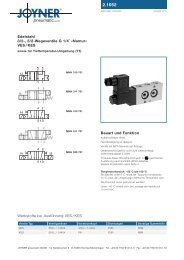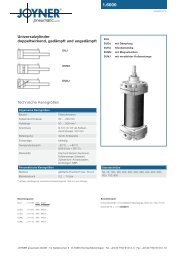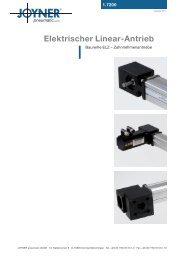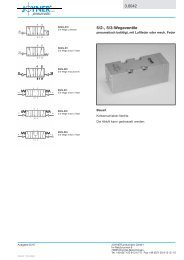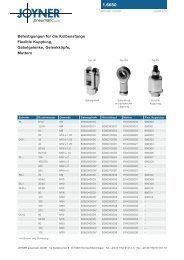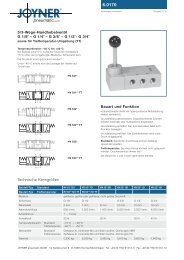1.7000_D - JOYNER pneumatic GmbH
1.7000_D - JOYNER pneumatic GmbH
1.7000_D - JOYNER pneumatic GmbH
Create successful ePaper yourself
Turn your PDF publications into a flip-book with our unique Google optimized e-Paper software.
<strong>1.7000</strong>.qxp:<strong>1.7000</strong> 03.03.2009 16:32 Uhr Seite 3<br />
<strong>1.7000</strong><br />
Zylinderschnitt – Cylinder<br />
– Cylinder<br />
section<br />
section<br />
– Construction<br />
– Construction<br />
Dichtband außen<br />
Outer band<br />
Bande d’étanchéité externe<br />
Zylinderkopf<br />
Cylinder head<br />
Fond du vérin<br />
Magnetstreifen<br />
Magnet stripes<br />
Bande magnétique<br />
<strong>1.7000</strong><br />
Druckluftzylinder Pneumatic Cylinders Vérins Pneumatiques<br />
Baureihe PL … - Linearzylinder Type of Cylinder PL … - Rodless Série PL … - Sans Tige<br />
Druckluftzylinder Pneumatic Cylinders Vérins Pneumatiques<br />
Baureihe PL … - Linearzylinder Type of Cylinder PL … - Rodless Série PL …- Sans Tige<br />
Kolbenachse und Lastkupplung<br />
Piston axle and load friction<br />
Chariot / Porte Charge<br />
Kolben<br />
Piston<br />
Dichtband innen Piston<br />
Inner band<br />
Bande d’étanchéité interne<br />
Zylinderrohr<br />
Tube<br />
Chemise du vérin<br />
Dämpfschraube<br />
End cushioning screw<br />
Réglage d’amortissement<br />
en fin de course<br />
Sensormagnete<br />
Sensor magnets<br />
Aimant pour détecteurs de position<br />
Funktionsbeschreibung<br />
Das Zylinderrohr ist achsial durchgehend geschlitzt. Die Kraftabgabe erfolgt über eine Lastkupplung, welche an der Kolbenachse befestigt ist;<br />
letztere ist so ausgebildet, dass ein durch den Rohrschlitz geführter Steg den inneren Teil der Kolbenachse mit dem äußeren Teil verbindet.<br />
Der Kraftverlauf ist also:<br />
Luftdruck → Kolbenfläche → Kolbenachse (innen) → Kolbenachse (außen) → Lastkupplung → Werkstück!<br />
Die druckfeste Abdichtung des Zylinderschlitzes wird mit einem präzisionsgeschliffenen, innen liegenden Stahlband erreicht; dieses wird<br />
mit 2 längs des Schlitzes verlaufenden Magnetstreifen in Position gehalten.<br />
Ein zweites Stahlband befindet sich außen auf dem Schlitz des Rohres. Es dient der Staubabdeckung.<br />
Beide Stahlbänder werden während der Kolbenfahrt genauso wie bei Stillstand hinter der Kolbendichtung vom Schlitz abgehoben und<br />
jeweils mittels eines eigenen Führungskanales durch die Kolbenachse geleitet. Davor und dahinter legen sich die Bänder wieder dichtend<br />
über den Zylinderschlitz.<br />
Description of function and design<br />
The entire tube is slotted throughout its full length. The force is transmitted through the load friction, which is attached to the piston axle.<br />
The design of the piston axle is that way that the inner part of the piston axle is connected through the slot with the outer part of it.<br />
Therefore the force transmission runs as follows:<br />
Air pressure → Piston area → piston axle (inner part) → piston axle (outer part) → load friction → load.<br />
The cushioning of the cylinder slot is garanteed by a most precisely grinded inner steel band. The inner band is kept in position due to magnet<br />
stripes which are placed on both sides of the slot. In addition there is an outer steel band covering the slot in order to keep dust out of inner<br />
space of the cylinder.<br />
During piston movement as well as during stillstand of it both steelbands are lifted right after the piston seal and led through the piston axle by<br />
means of a separate own guiding chanel. Before and behind the piston axle both bands are covering the slot permanently again.<br />
Principe de fonctionnement<br />
Le piston se déplace dans un tube en aluminium extrudé pourvu d’une fente longitudinale. Le chariot, auquel est fixée la charge, est entraîné<br />
par le piston au moyen d’un étrier de liaison. La force est transmise de la manière suivante:<br />
L’énergie pneumatique → piston → étrier → chariot → porte charge → masse à déplacer.<br />
L’étanchéité est garantie par la forme très précise de la bande d’étanchéité interne en acier. Cette bande interne est maintenue en position grâce<br />
à une bande magnétique placée des deux côtés de la fente. De plus, une bande d’étanchéité externe protège l’intérieur du vérin des impuretés.<br />
Pendant le mouvement du piston aussi bien que pendant l’arrêt, deux guides séparent les bandes pour permettre le passage de l’étrier dans<br />
la fente, puis les referment sur la chemise pour assurer l’étanchéité.<br />
Ausgabe 01/09<br />
<strong>JOYNER</strong> <strong>pneumatic</strong> <strong>GmbH</strong><br />
<strong>JOYNER</strong> <strong>pneumatic</strong> <strong>GmbH</strong> · Im Netzbrunnen 6 · D-70825 Korntal-Münchingen Im Netzbrunnen · Tel. +49 (0) 67150<br />
91312-0 · Fax +49 (0) 7150 91312-10<br />
D-70825 Korntal-Münchingen<br />
3 Telefon +49 (0) 7150 / 91312-0 · Fax +49 (0) 7150 / 91312-10



